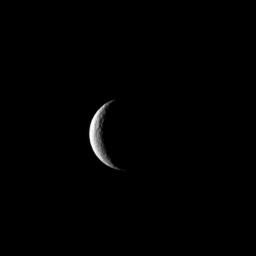Crescent Rhea
Caption:
The Cassini spacecraft captures Saturn's moon Rhea at crescent phase, a view never visible from Earth. Near the terminator, a few of Rhea's many craters show up in sharp relief.
With a diameter of 949 miles (1,528 kilometers) Rhea is Saturn's second-largest moon.
This view looks toward the leading hemisphere of Rhea. North on Rhea is up and rotated 12 degrees to the right.
The image was taken in visible light with the Cassini spacecraft narrow-angle camera on Nov. 6, 2012. The view was obtained at a distance of approximately 1.2 million miles (1.9 million kilometers) from Rhea and at a Sun-Rhea-spacecraft, or phase, angle of 129 degrees. Scale in the original image was 7 miles (11 kilometers) per pixel. The image was magnified by a factor of 1.5 to enhance the visibility of surface features.
Background Info:
The Cassini-Huygens mission is a cooperative project of NASA, the European Space Agency and the Italian Space Agency. The Jet Propulsion Laboratory, a division of the California Institute of Technology in Pasadena, manages the mission for NASA's Science Mission Directorate, Washington, D.C. The Cassini orbiter and its two onboard cameras were designed, developed and assembled at JPL. The imaging operations center is based at the Space Science Institute in Boulder, Colo.
For more information about the Cassini-Huygens mission visit
http://saturn.jpl.nasa.gov
. The Cassini imaging team homepage is at
http://ciclops.org
.
Cataloging Keywords:
| Name |
Value |
Additional Values |
| Target |
Rhea |
|
| System |
Saturn |
|
| Target Type |
Satellite |
|
| Mission |
Cassini-Huygens |
|
| Instrument Host |
Cassini Orbiter |
|
| Host Type |
Orbiter |
|
| Instrument |
Imaging Science Subsystem (ISS) |
|
| Detector |
Narrow Angle Camera |
|
| Extra Keywords |
Crater, Grayscale, Rotation, Visual |
| Acquisition Date |
|
| Release Date |
2013-02-11 |
| Date in Caption |
2012-11-06 |
|
| Image Credit |
NASA/JPL-Caltech/Space Science Institute |
| Source |
photojournal.jpl.nasa.gov/catalog/PIA14647 |
| Identifier |
PIA14647 |

 Planetary Data System
Planetary Data System
